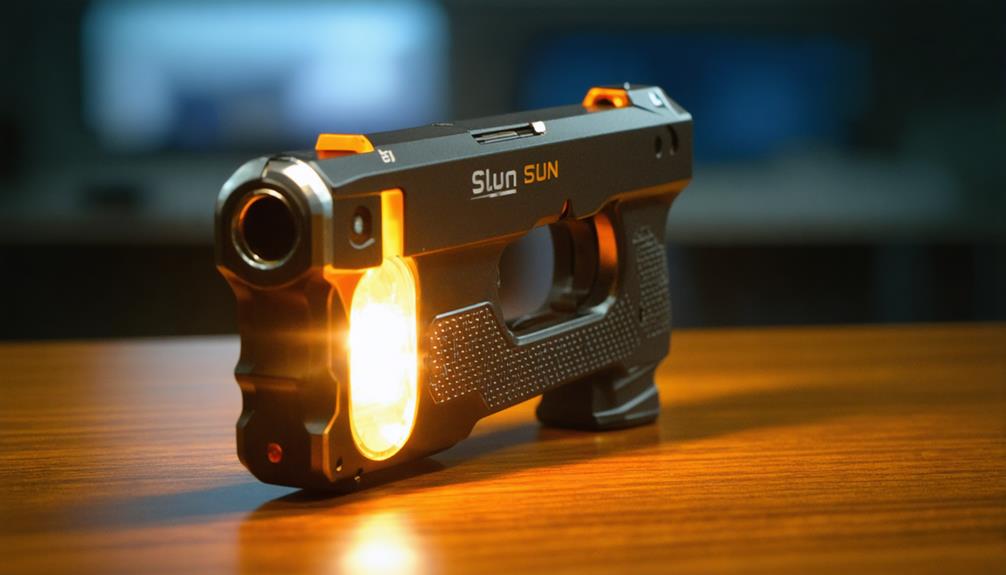
Brainstorm Security Shop

For Orders Over $199

On Any Of Our Products

Details On Refund Page
When considering personal safety, you might find yourself wondering about the effectiveness of a handheld stun gun. These compact devices promise a way to incapacitate an attacker with a high-voltage electric shock, but do you really understand how they work? From their technical specifications to their legal implications, there’s more to these devices than meets the eye. As you ponder the potential benefits and challenges, you may start to question which model suits your needs best and how to handle it safely in a critical situation.
How do handheld stun guns effectively incapacitate an attacker? These powerful devices deliver a high voltage output, usually ranging from 50,000 to several million volts, which can temporarily disrupt an assailant’s muscle control and motor functions. When you press the trigger, the stun gun releases a precise electric shock that interferes with the body’s electrical signals.
This electric shock causes immediate pain and disorientation, giving you the crucial time you need to escape or call for help. The voltage output creates a short circuit in the nervous system, which can overwhelm the attacker’s ability to respond effectively.
The beauty of a stun gun lies in its ability to incapacitate without causing lasting harm, allowing you to defend yourself without the fear of serious injury to your attacker.
Moreover, the stunning effect typically lasts for several minutes, ensuring that the threat is neutralized long enough for you to get away safely. In a tense situation, understanding how these devices work can empower you to make quick decisions, enhancing your personal safety and confidence when facing potential danger.
Stun guns frequently offer a practical solution for personal safety, providing users with a non-lethal means to defend themselves against potential attackers. When you’re concerned about your safety, these devices can empower you by giving you a way to deter threats without causing permanent harm.
Here are three key benefits of using stun guns for self defense:
When considering a handheld stun gun, you need to understand the legal landscape in your state. Regulations can vary significantly, so it’s crucial to know the specific laws regarding possession and carrying. By staying informed, you can ensure you’re using your stun gun responsibly and within the law.
Navigating state regulations on handheld stun guns can be tricky, as laws vary significantly across the country. Understanding state legislation is crucial to ensure you’re compliant and prioritizing public safety. Here are three key points to consider:
Carrying a handheld stun gun comes with specific legal considerations that vary by state. You need to be aware of carrying limitations and age restrictions before you decide to carry one. Some states may allow you to carry a stun gun openly, while others have strict regulations. Knowing your local laws can save you from potential legal troubles.
Here’s a quick reference table to help you understand some common restrictions:
| State | Carrying Limitations |
|---|---|
| California | Allowed with restrictions |
| New York | Prohibited |
| Texas | Allowed, no permit needed |
| Florida | Allowed with age restrictions |
In many states, you must be at least 18 years old to carry a stun gun. Additionally, certain public places may prohibit their carry, such as schools and government buildings. Always check your state’s regulations to ensure you’re compliant. Ignoring these rules can lead to severe penalties, including fines and confiscation of the device. Stay informed and carry responsibly.
Choosing the right stun gun requires careful consideration of several factors to ensure it meets your needs. One of the most critical aspects is the voltage comparison. Higher voltage models can deliver more incapacitating force, but you should also consider how manageable the device feels in your hand.
Next, think about the size options available. A compact stun gun may be easier to carry, but you don’t want to sacrifice effectiveness. Balance portability with power to find the right fit for your lifestyle.
Here are three key factors to consider when choosing your stun gun:
When it comes to using a stun gun effectively, understanding proper techniques and safety measures is essential. First, always keep your stun gun within reach and ensure it’s charged. Aim for the target’s center mass, as this increases stun gun effectiveness. Remember to maintain a safe distance; getting too close can make you vulnerable.
Here are some safety tips to keep in mind:
| Do’s | Don’ts |
|---|---|
| Test your stun gun regularly | Use it recklessly |
| Familiarize yourself with its operation | Point it at others for fun |
| Keep it out of reach of children | Ignore local laws on usage |
| Use it only in self-defense situations | Rely solely on it; know stun gun alternatives |
| Stay calm and focused | Panic or hesitate in a threat situation |
Always consider stun gun alternatives like pepper spray or personal alarms for added safety. Knowing your options can enhance your self-defense strategy. Stay aware of your surroundings, and practice using your stun gun responsibly. This preparation will ensure you’re ready if you ever need to defend yourself.
Maintaining your stun gun is crucial for ensuring it functions correctly when you need it most. Regular care won’t only prolong its lifespan but also guarantee that it’s ready for action. Here are some essential cleaning tips and storage recommendations:
Using stun guns on animals raises serious ethical considerations. You should prioritize animal safety and explore non-lethal alternatives for self-defense. Always consider the impact on the animal and the potential legal implications of your actions.
The effective range of a handheld stun gun typically extends up to 15 feet. However, you should consider safety concerns and legal restrictions in your area before using it in any situation. Always stay informed.
Whether stun guns require a license depends on your location’s legal requirements. It’s crucial to check local laws, as safety concerns often dictate regulations. You should always prioritize safety and compliance when considering ownership.
The charge on a stun gun typically lasts several months, depending on usage. Stun gun durability and battery life vary by model, so check your device’s specifications to ensure you’re prepared when needed.
Using a stun gun can lead to physical effects like temporary pain or muscle contractions and psychological impacts such as fear or anxiety. It’s crucial to consider long-term consequences and potential risks before deciding to use one.
